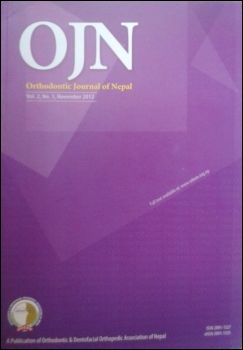Clinical Evaluation of Fixed Partial Dentures with Cast Joined Pontics
DOI:
https://doi.org/10.3126/ojn.v3i1.9284Keywords:
cast connector, cast joining, preceramic soldering, solderingAbstract
Introduction: It requires great skill and material selection to achieve proper solder joint. It is more difficult to perform when one is working with the base alloy. Similar joint can be achieved by cast joining. But no clinical evaluation has been described in the literature about this technique.
Objective: To evaluate the clinical success of cast joining in porcelain fused to base alloy fixed partial denture.
Materials & Method: The metal frameworks of long span fixed partial denture that did not fit satisfactorily during metal try-in were sectioned through pontics. The pontics were grossly reduced and designed to achieve mechanical interlocking. Then they were connected by self-cure acrylic resin in the patients’ mouth after achieving proper fit. They were reinvested in casting rings and recasting was done. After further try-in, ceramic application were completed and cemented in patients’ mouth. Marginal fit, cervical caries, mechanical strength and metal ceramic bond in joined areas were clinically assessed using Ryge Clinical Criteria.
Result: 15 patients were available for follow up. Each patient had worn the fixed partial denture for more than a year. When clinically assessed the marginal fits were acceptable. None of the patients had any cervical caries. None of the fixed partial denture had failed mechanically. There were no cases of ceramic fracture in the pontics areas.
Conclusion: Cast joining could be one of the alternative techniques of soldering and welding in fixed partial denture provided that the split is done through the pontic area and well designed to achieve maximum mechanical interlocking.
DOI: http://dx.doi.org/10.3126/ojn.v3i1.9284
Orthodontic Journal of Nepal, Vol.3, No.1, 2013: 58-62
Downloads
Downloads
Published
How to Cite
Issue
Section
License
Copyright © held by Orthodontic & Dentofacial Orthopedic Association of Nepal
- Copyright on any research article is transferred in full to the Orthodontic & Dentofacial Orthopedic Association of Nepal upon publication in the journal. The copyright transfer includes the right to reproduce and distribute the article in any form of reproduction (printing, electronic media or any other form).
- Articles in the Orthodontic Journal of Nepal are Open Access articles published under the Creative Commons CC BY License (https://creativecommons.org/licenses/by/4.0/)
- This license permits use, distribution and reproduction in any medium, provided the original work is properly cited.




